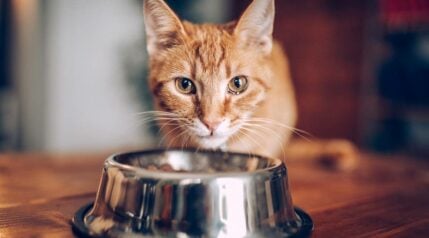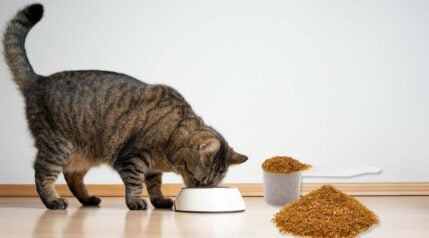When you purchase through links on our site, we may earn a commission. Here’s how it works.
Flour, water, salt, and yeast. With minimal ingredients, you can make 100+ types of bread—from naan and challah to sourdough and focaccia. And as we all know, few things are more satisfying than biting into a crispy-on-the-outside, soft-on-the-inside slice of freshly baked bread. But can cats eat bread? Yes and no.
Cats can snack on a small amount of bread without getting sick, but carbohydrate-heavy foods are not ideal for felines. Moreover, consuming certain breads and bread dough is potentially hazardous to our kitty companions.
For the most careful pet parent, the safest and healthiest route is to avoid feeding your cat bread entirely. Still, you can also prevent a trip to the vet by learning which types of bread are and are not safe for felines to eat.
Is Bread Safe For Your Cat To Eat?
Fully baked bread is safe for cats, so long as it doesn’t contain any other ingredients that are toxic to our pets. Avoid feeding your feline slices that contain raisins, garlic, onions, or chives. These ingredients are all dangerous for cats to consume.
Some breads also contain dairy via the addition of milk or butter. Because most adult felines are lactose intolerant, these lactose-filled loaves are not recommended for our furry friends.
The American Society for the Prevention of Cruelty to Animals (ASPCA) also warns that uncooked, yeasted bread dough is dangerous for felines. Raw yeast ferments the carbohydrates in bread dough, producing ethanol and carbon dioxide. When uncooked dough is ingested, this process continues in the stomach and can lead to your pet becoming disoriented and bloated. Eating raw dough will likely cause GI discomfort, nausea, and vomiting.
Remember that while some kitties may be able to eat a small portion of cooked bread, others may have a hard time digesting this carb-heavy food. All felines are obligate carnivores, meaning they need meat to survive. While our pets can digest and absorb carbohydrates, too many cause digestive distress. In addition, there’s always a chance that your kitty is allergic to one of the ingredients in the loaf.
Cat food allergy symptoms include:
- Digestive problems (diarrhea, vomiting)
- Increased scratching or biting of skin
- Skin inflammation (rash, sore)
Can Kittens Eat Bread?
Your kitten will begin eating solid foods around 3-5 weeks. While your kitten may have a growing interest in human foods, it’s best to keep a strict diet if your kitty is very young. A kitten’s diet is crucial for proper development, and feeding them human treats could upset their digestive system or make them too full when it comes time for their regular meals.
Is Bread Bad For Cats?

Bread isn’t necessarily bad for cats. It’s not healthy for them, either. Some carbohydrates, like fruits and vegetables, offer antioxidant benefits that your companion may not otherwise receive through their diet. For example, blueberries, cranberries, spinach, and carrots are all high in antioxidants, which is why you’ll find these ingredients in some pet recipes. Your standard loaf of white bread is not a quality source of vitamins, minerals, or antioxidants. In actuality, bread may contain antinutrients, which block your body from absorbing certain minerals.
What Types Of Bread Are Safe For Cats To Eat?
Generally speaking, bread is safe for felines to eat, so long as it’s fully baked. Loaves that are safe for cats include white, wheat, rye, and sourdough.
Other cat-safe breads include:
- Baguette
- Boule
- Ciabatta
- English muffin
- Multigrain
- Pita
- Sprouted grain (confirm there are no added raisins)
- Whole wheat
Which Types Of Bread Are Bad For Cats To Eat?

Your standard loaf of bread contains flour, water, salt, and yeast. However, enriched or sweet dough typically contains milk, butter, eggs, and sugar. When buying packaged bread, check the ingredient list for dairy. These include milk, cream, butter, and yogurt.
Other loaves contain added chocolate, nuts, seeds, and spices that are toxic to cats. For example, banana bread often includes ingredients like chocolate, raisins, and nutmeg—all of which can poison our furry friends.
Here are types of breads that should not be given to your cat:
- Breadsticks often feature a garlicky butter topping
- Brioche contains dairy milk
- Challah contains butter and may have a toxic-to-cats poppy seed topping
- Cornbread is made with milk or buttermilk
- Focaccia may include minced onion, which is toxic to cats
- Japanese milk bread, also called shokupan or Hakkaido milk bread, contains dairy (milk, cream and/or butter)
- Lavash may contain milk
- Naan typically contains milk
- Onion bread is poisonous to felines
- Pumpernickel may contain coffee grounds or cocoa, both of which are harmful to our feline friends
- Soda bread contains buttermilk that may cause your cat to experience digestive upset
How To Feed Bread To Cats
In a perfect world, you will avoid feeding your kitty bread. Felines thrive on high-quality pet-specific products that are designed for cat consumption. While bread isn’t the optimal snack option for our furry friends, cats often opt to sneak human foods. My kitty, Lucy, loves carbs and would happily bite through the plastic wrap to sink her teeth into a bread loaf. If your pet can’t resist the call of freshly baked bread, make sure to only give them plain bread without any topping. Spreads or mix-ins are likely unhealthy—at worst poisonous—to felines and should be avoided.
If your pet is new to bread, treat it like any new human food. Start by feeding a small amount and monitor for adverse reactions. If in doubt, consult your veterinarian. Before introducing bread to your feline, your vet can evaluate your cat to confirm there aren’t any underlying digestive issues that will increase the likelihood of bread making them feel sick. If your kitty is showing any negative reactions after eating bread, call your veterinarian for guidance.
Before feeding your feline human foods, consider purchasing pet insurance to help cover the costs of food-related accidents and illnesses.
Frequently Asked Questions
What Should I Do If My Cat Eats Raw Yeasted Bread Dough?
If your cat eats raw yeasted dough, seek out your veterinarian or an emergency clinic immediately. Raw dough continues to expand when ingested and may cause severe bloating. Even a tiny amount of raw yeasted dough can quickly produce enough carbon dioxide and alcohol to cause significant problems for your feline. Be sure to note how much dough your kitty consumed. Depending on the amount your pet ate, your cat may need life-saving medical attention. Too much ethanol can cause alcohol poisoning, which can be fatal.
Can Cats Eat Bread Crust?
Yes, your feline can eat bread crusts. If it’s a thick crusted, hard bread, make sure the piece is small enough to avoid choking.
Can Cats Eat Bread And Butter?
Avoid feeding your feline buttered bread. While butter isn’t poisonous to furry friends, it does contain lactose. Signs of lactose intolerance include abdominal discomfort, bloating, diarrhea, and vomiting.
Final Thoughts
What happens if a cat eats bread? Generally, nothing terrible will happen if your cat nibbles on a bit of bread. Still, there are better snack choices than bread for cats. There are plenty of human foods that are safe for cats, including meats, fruits, and vegetables. Turkey, shrimp, and steak are all good treat options. Low-sugar fruits like blackberries, cranberries, and strawberries are also okay. For vegetables, try broccoli, carrots, or sweet potato.





